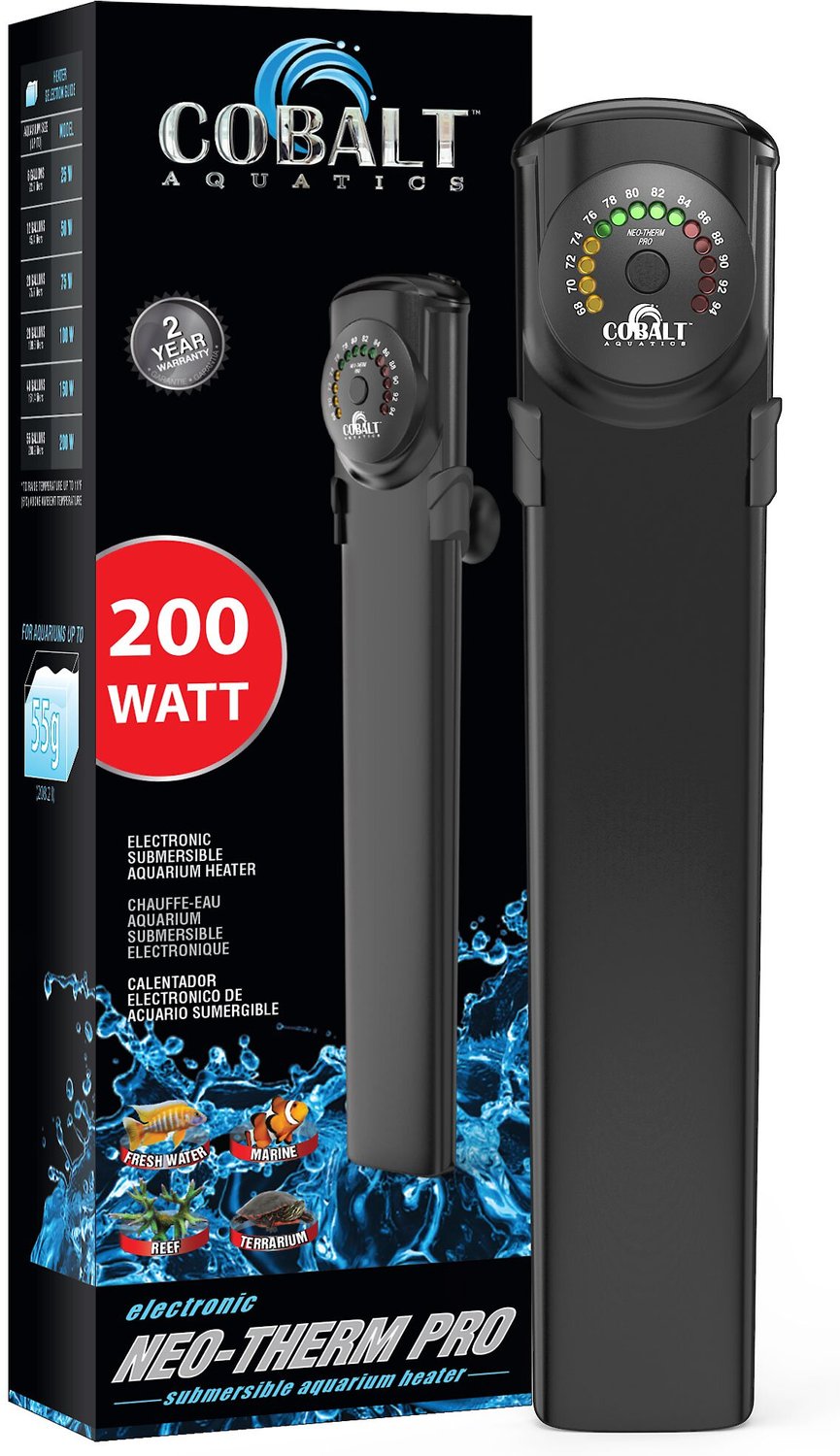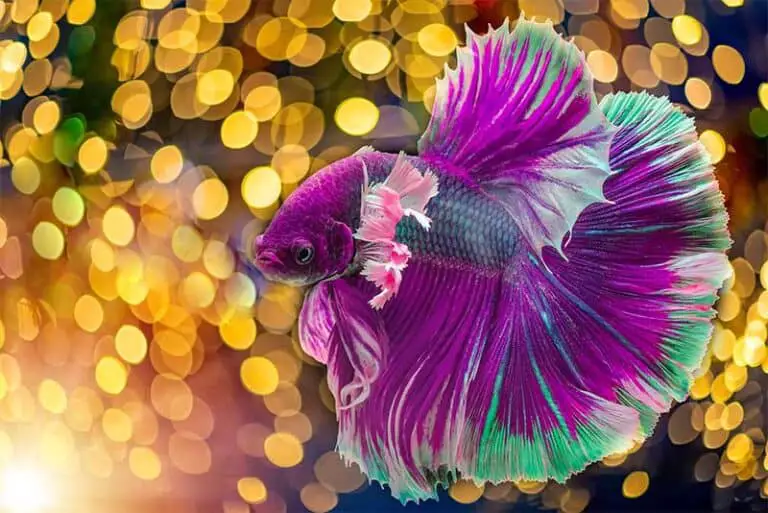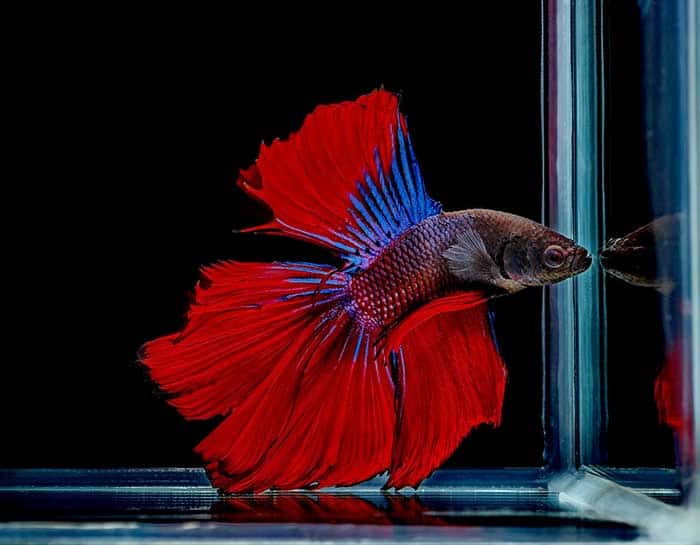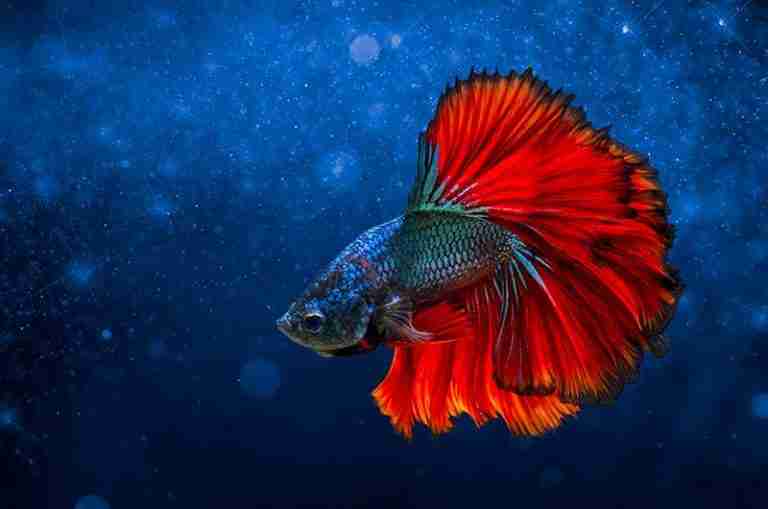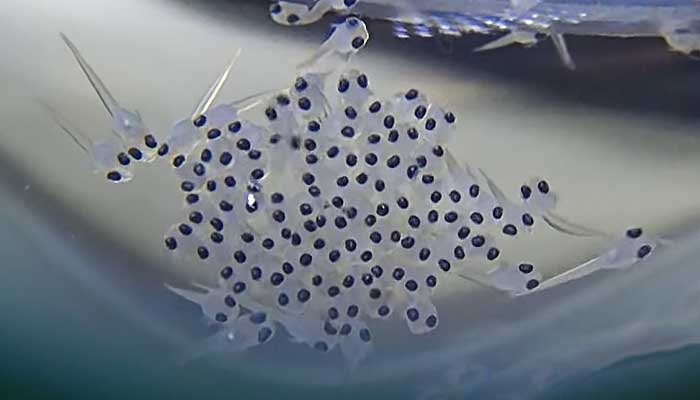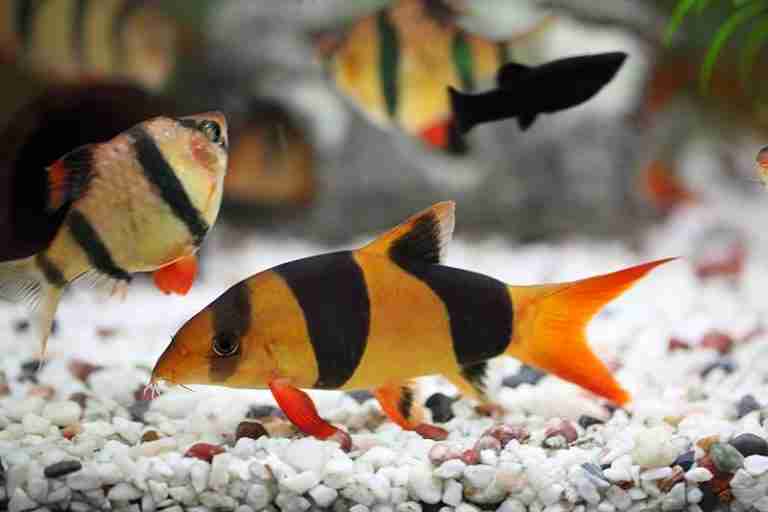Betta Fish Care Guide And Species Overview For Beginners
Betta fish (Siamese fighting fish) or (Betta Splendens) are among the most popular types of tropical, freshwater, aquarium fish. Betta fish are pretty easy to care for, making them an excellent pet for beginner to intermediate fish keepers.
This betta fish care guide covers everything you need to know, including their natural habitat, lifespan, size, tank requirements, diet, and expected behaviors.
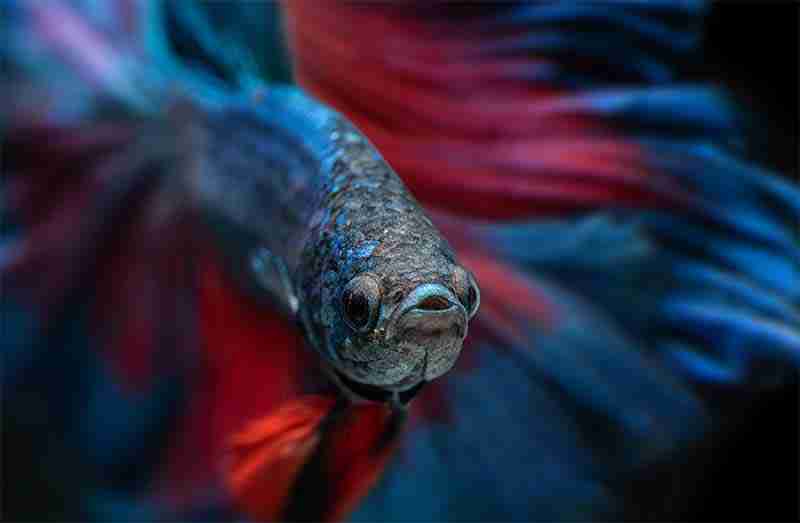
Betta Fish – Species Overview
The table below provides a quick overview of the betta fish.
| Description | Value |
|---|---|
| Scientific Name | Betta Splendens |
| Common Name | Betta Fish Or Siamese Fighting Fish |
| Origin | Southeast Asia |
| Adult Size | 2-3 Inches |
| Average Betta Lifespan | 2-5 Years |
| Minimum Tank Size Per Adult | 2.5-5 Gallons |
| Tank Dwelling Level | Mid-Upper |
| Social Type | Variable (Can be aggressive toward other male betta and incompatible fish) |
| Solitary Or Schooling Fish | Solitary |
| Diet | Carnivorous (Insects, worms, and small fish) |
| Breeding | Spawners – Not overly difficult To Breed |
| Betta Water Parameters | pH: 6.5-7.5 (Neutral) Water Hardness: GH: 3-4 dGH (50-66.7 ppm) KH: 3-5 dKH (53.6- 89.4 ppm) Temperature: 78° to 80° Fahrenheit (25.5° – 26.7° Celsius) Ammonia and Nitrite: 0 ppm Nitrates: <20 ppm |
| Care Difficulty | Beginner To Medium |
Betta Fish Care Guide
Good betta fish care will make a difference to the overall quality of life your betta will have, which will impact its health, happiness, and lifespan.
Betta fish are not very difficult to care for, and with the right knowledge, you can avoid the common mistakes and pitfalls that many novice betta owners succumb to.
Throughout this article, you will learn a little about the history of betta fish, their natural habitat, behaviors, diet, favored living conditions, and much more.
This guide and the links throughout will provide you with the knowledge you will need to give the best care to your betta fish.
Brief History Of The Betta Fish
The name “Betta” fish comes from an ancient word in the Southeast Asian language of Malay. The name translates to mean “fighting fish,” hence the name Siamese Fighting fish.
Betta fish were originally collected for aquariums in the 1800s when breeders selectively bred betta fish due to their aggressive nature. As a result of this selective breeding, different varieties of betta fish quickly emerged.
Siamese fighting fish were often used in organized fights held for gambling purposes. Because these fights could sometimes be to the death, organizers drew up rules to avoid fatalities. Once a betta fish would retreat from a battle, the aggressor was deemed the winner, and they would be separated.
Betta fights still happen to this day and has become a solid part of Thai culture.
Interesting Fact
The Siamese Fighting Fish is the national aquatic animal of Thailand
Types Of Betta Fish
Because of the large amount of cross-breeding that has taken place with betta fish, there are now many different types available to buy. They are generally classified and named based on their appearance, either in their tail, colorations, or patterns.
There are so many types of betta that no two are identical, and this article will not cover them all, so instead, I will list some of the most common variations below.
Betta Fish Based On Fin Type
The main variations of betta based on their fin type or shape are:
- Veil tail Betta.
- Half Moon Tail Betta.
- Crowntail Betta.
- Plakat Betta.
- Double Tail Betta.
- Comb Tail Betta.
- Delta Tail Betta or Super Delta Tail Betta.
Some of those listed above are extremely common and will be found in most fish stores, whereas others are much less common, and you will need to approach a specialist breeder or dealer.
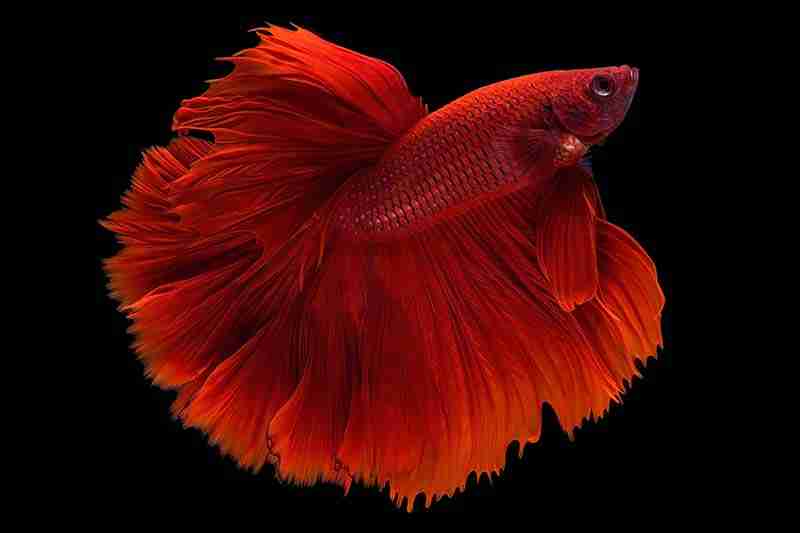
Betta Fish Based On Coloration And Patterning
Some of the most common types of betta fish based on color and pattern are:
- Bicolor Betta (Red and black, orange and yellow).
- Pineapple Betta (red with yellow markings).
- Marble Betta (mostly solid color, but with white patterning).
- Cambodian Betta (solid color body, but with red or blue fins).
- Electric Blue/Green/Turquoise Betta.
- Albino Betta.
- Rosetail (red ends to the tail, a result of breeding betta splendens and betta imbellis).
- Reddy Halfmoon (combination of red and fawn colors).
- Piebald (no black pigmentation in the body, but with red fins from betta splendens and betta imbellis).
How Many Species Of Betta Fish Are There
There are approximately 73 species of the Betta genus, but not all of them are readily available to buy. Many betta fish are bred by specialist breeders who will carefully cultivate specific colors and tail shapes, and many of these I have included in the lists above.
The more common species of betta fish can be found in many fish stores and are best for hobbyists, whereas the rarer breeds will need to be sourced directly from specialist breeders at a higher cost.
Which Are The Most Popular Betta Fish
The most popular species of betta fish are betta splendens, of which the veiltail, full-moon tail, half-moon tail, double tail, royal blue, and crowntail varieties are readily available.
The next most common betta fish is Betta imbellis, also known as the peaceful betta or the betta commonly kept as pets.
Other popular varieties of betta fish are the Slender betta (betta bellica), the Emerald betta (betta smaragdina), the Mouthbrooding betta (betta pugnax), and the Combtail betta (betta strohi).
What Is The Rarest Betta Fish
There are many rare types of betta fish, usually rare due to their specific coloring and tail shapes. Certain colors are more challenging to breed than others because of gene limitations.
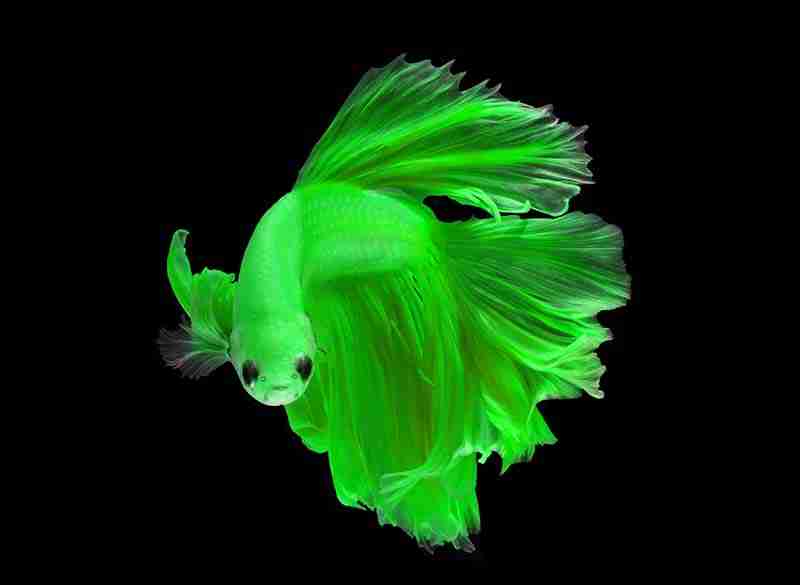
Some of the rarest are:
- Albino bettas (True albino betta fish are quite hard to find. They are usually pure white, and they tend to suffer from many health conditions).
- Cambodian betta fish (red body with cherry red fins. These are hard to find due to their specific coloring).
- Electric blue bettas (These are striking betta fish that are bright blue all over, including their fins. They are rare because of their specific coloration).
- Red and black bettas (These are similar to Cambodian Betta Fish, except they have a solid red body instead of an orange one. They are quite popular because of their striking appearance).
- Green Betta (A bright green in color, these are also a rare find).
- Golden bettas (The golden color is caused by a genetic mutation that can be triggered in other species of betta also).
- Purple betta (This color is extremely difficult to achieve in betta fish, and so makes them a rare find).
- Rosetail bettas (This is a very unique look that not many people have seen before. This type of betta fish has red fins, but lacks any other coloration on its body).
- Red phantom bettas (These are rare because the female must be crossed with a male veiltail in order to produce the red variation).

The rarest betta fish, or at least the most expensive ever sold was bred into the color of the Thai national flag and was bought for $1,530 at an online auction.
Betta breeding is relatively easy and is something that many novice betta owners have begun to attempt themselves, often with abnormal results. If you read through some betta forums online, you will find many discussions around breeding results, such as dwarf bettas with fully mature and normal fin growth.
You would need to be very careful if purchasing a betta from a breeder, as they may have been exposed to hormones, which can result in genetic deformities or premature death.
Natural Habitat Of Betta Fish
Betta fish are native to many parts of Southeast Asia, but they can now be found worldwide. Today, they are one of the most popular tropical freshwater species owned by many aquarists worldwide. This popularity has led to high demand and wild betta populations decreasing dramatically over the past decade.
Are Betta Fish Endangered
The decrease in wild betta splendens has helped them find their way onto the IUCN Red List, which classes many bettas as vulnerable, and some species of betta are considered endangered.
There are two main reasons for the dramatic decline in the numbers of Siamese fighting fish:
- The excessive fish trade for both the fishkeeping hobby worldwide and trading in the local markets for fighting.
- Changes to their habitat due to deforestation and water pollution.
Where Do Betta Fish Live In The Wild
Betta fish are often found in shallow, stagnant, warm water such as rice paddies. They are labyrinth fish with the distinct ability to breathe oxygen straight out of the air due to a labyrinth organ that helps them live in these poorer water conditions. Betta fish can also be found in slow-moving waters like swamps and floodplains and enjoy the heavy plant cover.

Because betta fish are generally found in shallow water, many people believe they are suited to small aquariums. This is not entirely true as the shallow water where they live is also quite vast, and these small bodies of water will often connect, forming much larger bodies of water.
Betta fish are very territorial and need plenty of room or hiding places to coexist peacefully with other bettas. The wild betta’s lifespan is understood to be much shorter than in captivity because of fighting and disease.
Betta Fish Size
Baby bettas will usually measure around 1-2 millimeters at hatching, and as adults, betta fish can grow to 2.5 to 3 inches from the tip of their mouth to the base of their tail. Female bettas tend to be a little smaller as they don’t have such large fins and plumage, so you can expect the average female to grow to around 2 inches in length.
Betta Fish Lifespan
The average life expectancy of a betta fish is approximately 2-5 years in captivity, depending significantly on their living conditions. A well-cared-for betta should live to its whole potential lifespan. In some cases, this has been reported as between 6 years and even 10 years of age, although 10 years is an exception and very unlikely.
Siamese fighting fish are usually around one year old when sold in pet stores because their plumage is fully developed, and they are more desirable to purchase. It can be essential to understand a betta’s potential age when sold, as this can help you when aging your betta.
If you want to know how to tell if your betta fish is dying of old age, you will need to establish the approximate age of your betta.
Betta Splendens are prone to several diseases and illnesses throughout their lifetime. An experienced aquarist will be better able to spot the onset of ill health much quicker, so treatments will be more likely to succeed and prolong a bettas life.
A well-maintained tank with water kept within the recommended parameters, a decent filter, and an aquarium heater will also go a long way to providing the best betta care. It will help your betta fish achieve a long and healthy life.
Betta Fish Tank Size
Good betta care is not just about feeding them well and cleaning their tank often. Betta fish should be given plenty of room to move and have a large enough tank that is well decorated, planted, and will ideally contain a filter and heater. So what size tank does a betta need? A 10-15 gallon tank would be a suitable size for a single betta, although they can survive in a 5-gallon tank or smaller.
I mentioned earlier that because betta fish can be found in the shallow water of the rice paddies of Thailand, many people believe that smaller tanks are sufficient. This is not the case, as I also explained that these shallow bodies of water would generally connect to form a much larger body of water which a smaller tank will not provide.
I also explained that a betta fish’s natural habitat is heavily planted, which is crucial for them to feel comfortable as they are used to hiding from predators and members of their own species.
A betta confined to a small tank will survive just fine, but it does not provide the ideal conditions, and smaller tanks are much harder to maintain than larger tanks.
Many pet stores sell specially designed and funky betta tanks that would look great in most homes. These tanks are often tiny and, in my opinion, much too small for a betta to live. They usually don’t have room for a filtration system and are certainly not big enough to decorate with plants and ornaments.
It is also true that many betta fish are kept in small bowls or even antique-looking bottles. Although this may look very stylish and has become a bit of a trend, it is not very practical and would likely cause a betta fish much stress, eventually leading to illness and, therefore, a much shorter life.
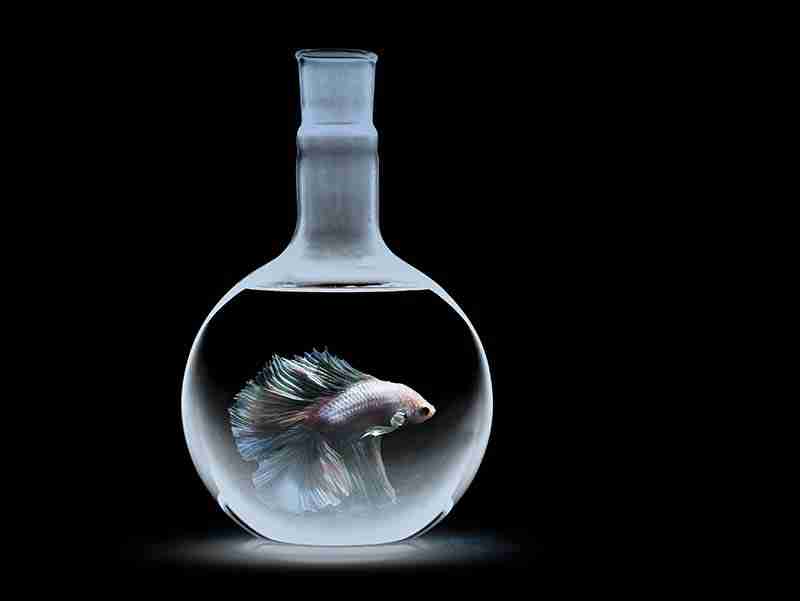
Betta Fish Tank Setup
The ideal betta fish tank setup is one that closely resembles its natural habitat. It is not good enough for a betta to merely survive. A betta’s tank should be as large as possible and contain some décor, such as plants and rocks.
There are several considerations when setting up a betta tank, such as:
- How to heat your tank.
- Type of lighting to use for betta fish.
- What type of substrate is best suited for betta fish.
- Water parameters that your betta prefers.
- Tank mates for your betta if you are choosing a community tank setup.
- Does your betta tank need an air pump?
If this is your first betta fish, I have an excellent guide on how to set up a betta tank. Later in this article section, I will link to some articles on how often to clean a betta tank and how often to change the water in a betta tank. These guides will give you an excellent introduction to betta care and provide you with the knowledge to keep your betta environment as healthy as possible.
I also have an article on fish tank pH levels that will help you to understand how to maintain the correct water pH of 6.5-7.5 that betta fish prefer.
How To Heat A Betta Tank
Betta splendens are tropical fish and are therefore used to a warmer climate. Your betta fish’s tank will need a consistent temperature, and you should keep the water parameters within a particular range, which I will discuss further below.
Betta fish are pretty resilient because of the water conditions they have adapted to in the wild, and they can cope well with varying temperatures. The main thing to consider with betta fish is that sudden changes to water conditions or temperatures can cause them to become stressed, leading to illness.
The ideal temperature range for a betta fish is between 78° to 80° Fahrenheit (25.5° – 26.7° Celsius). Between this range, a betta fish will be at its most comfortable, its healthiest, and you will more than likely see many of its natural behaviors.
Betta fish can survive at temperatures of between 72° and 86° Fahrenheit (22.2° – 30° Celsius). Please note that I said betta fish could SURVIVE at these temperatures, but they are not ideal, and you should aim to keep your betta tank water within the suggested range.
If you don’t already have one, consider getting a betta fish heater or just a standard fish tank heater. The use of an aquarium heater is the best way to keep your betta’s water temperature consistent throughout the day and night and through the changing seasons.
Eheim Jager Thermostat Aquarium Heater 50W
Equipped with precise control, simple recalibration, and an easy-to-read control lamp, this top-tier thermometer helps you keep your desired temperature.
This fully submersible heater has an auto dry-run shut-off to avoid damage when your tank water drops below the required level.
The 50W heater can be used in aquariums from 10-20 gallons with a range of other wattages available from 25-300W.
Cobalt Aquatics Neo-Therm Pro Aquarium Heater 200W
My favorite in this list, the Neo-Therm Pro is a great-looking, modern heater with a shatterproof design. Fully submersible with a one-touch system that is easy to set up, this heater is easy to use and accurate to 0.5°F
Easy-to-read LEDs show both the ‘set’ temperature and ‘current’ temperature simultaneously, and it has built-in thermal protection circuitry.
This 200W heater is perfect for large tanks of up to 55 gallons, with a range of other sizes for larger and smaller tanks.
Substrate For Betta Fish
The ideal substrate for a betta fish will allow it to burrow and create a lair for itself if it feels threatened or wants privacy. Many substrates can be used, but my personal favorite is sand, as this substrate is often very cheap and gives your betta plenty of room to swim around and hide from other fish.
In the wild, betta fish are used to clay or a muddy substrate, so you may want to consider using one of these. However, most people prefer using a gravel substrate for their betta fish which is fine and a personal choice.
If you prefer a gravel type of substrate, I would suggest looking at a smoother pebble to avoid causing any injuries. You may find your betta fish rubbing on rocks or substrate to relieve itchiness when they develop certain skin diseases such as ich or fin rot. Rubbing against sharper stones and jagged edges may damage their scales or delicate fins.
Betta Tank Lighting
Lighting is an essential part of any fish tank, so what type of lighting will suit your betta? Artificial light will enable your betta fish to get the correct amount of light throughout the day, and you can switch it off at night to mimic natural light.
Any standard aquarium light will suffice, and many fish tanks come with lighting pre-installed into the hood of the tank. A tank with a pre-installed light is the easiest option, but many betta owners will want something a little more unique.
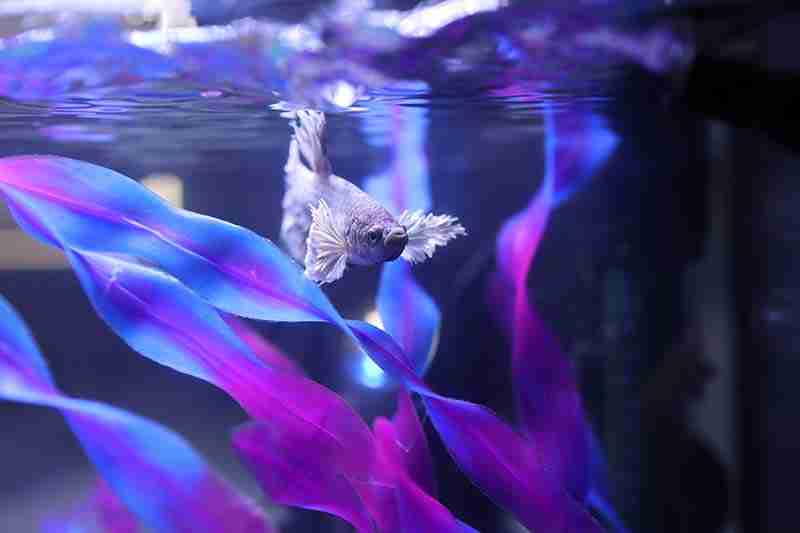
Betta fish have become pretty cool to own, which has brought about a variety of tank styles to look even cooler within a living room or office space. The ambiance is another key to creating a unique look to the tank, and there are many styles and colors of light which can be installed into a betta tank.
Led lights have become very popular as they can last for years and can often be easily adjusted in brightness and color. Although these lights look great, if considering good betta care, we need to ask ourselves whether they are suitable or whether they may cause your betta any harm or stress.
Do Betta Fish Like Led Lights
Betta fish need a natural day/night cycle, which is the most important consideration when lighting your bettas tank. Your betta will need approximately 8-12 hours of light per day, with around 12-16 hours of darkness (or near darkness) for a natural circadian rhythm. A fish’s circadian rhythm will help maintain correct body function and health.
Whether your betta’s tank is lit by led lights or by a fluorescent tube makes no real difference when providing your betta with a day/night cycle. Light also comes in many color wavelengths, so should this also be a consideration?
I have written an informative guide: Do Betta Fish Need Light?, which answers most questions about betta lighting.
Do Betta Fish Like Colored Lights
There has been very little study into whether colored light has an impact on a betta’s health. The color of artificial light has always remained in the warmer red/orange/yellow temperature range, which is comparable to a bright sunny day. As the sun goes down or if the sky is overcast, the light becomes more of a blue hue.
In the wild, these colors are a natural part of the light spectrum that betta fish are accustomed to, although with the advent of LED lights, there is now an infinite number of hues to light a betta tank. Outside of the natural color spectrum, betta fish aren’t visibly disturbed by the light. Still, in my opinion, it should be limited, and a betta should have some exposure to the natural color range of light.
Some betta owners like to light their fish tank softly with a blue hue at night, which should be fine as long as the light is soft. Moonlight will emit a soft blue light, so mimicking this light is ok unless your betta appears stressed or if you feel your betta isn’t sleeping. I would always suggest turning your fish tank light off when you go to bed.
Betta fish are quite happy with the light off in their tank, and although bettas can’t see in the dark quite as well as some fish, they can certainly navigate the tank without too much of a problem.
Decoration And Plants for a Betta Tank
If your betta tank is big enough, you can add some decoration and plants. The decoration doesn’t need to be anything extravagant; a betta is not an overly active fish. A piece of driftwood, a plastic tube, or some rocks to hide behind will be sufficient. The best betta tank will contain 2-3 ornaments that break up the space nicely but not too much.
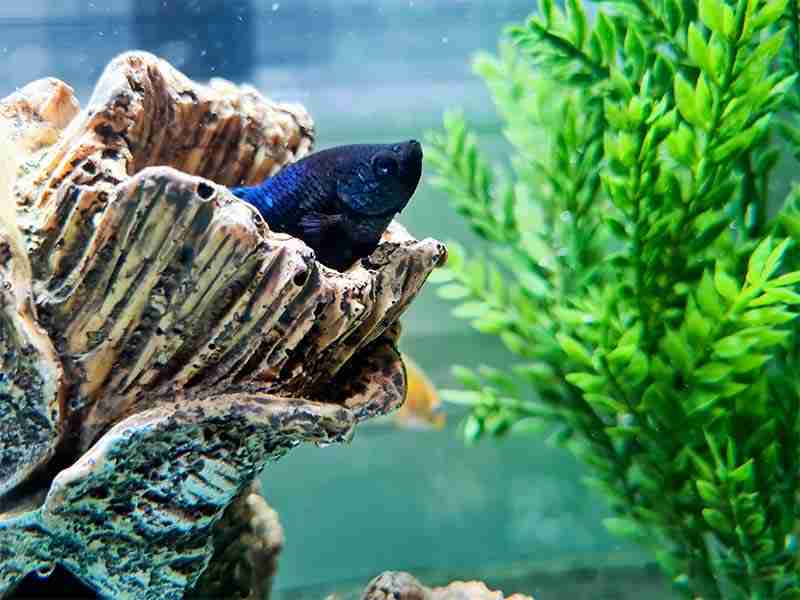
Plants are beneficial for a betta tank as they will provide a good amount of coverage to hide and for your betta to sleep in peace. It doesn’t matter if you use live plants or artificial plants as long as they provide some hiding places and privacy.
Live plants also help provide a good amount of beneficial bacteria and oxygen, which will help your betta fish tank cycle faster.
The best plants for betta tanks are:
- Java moss
- Java ferns
- Anubias
They are low-maintenance, durable, and provide plenty of cover for your betta to hide.
Most fish stores stock a good variety of aquarium plants, and you can also find a wide variety of aquarium plants online which are usually well-packaged and arrive in very good health.
Click Here to check Amazon’s wide variety of aquarium plants
Cleaning Your Betta Tank
Good betta care will require you to perform regular water changes and general cleaning of your fish tank. If you have a smaller fish tank without filtration, you will need to clean it more often than a larger fish tank with filtration.
Betta fish are pretty hardy and can tolerate poor water conditions in the wild. As labyrinth fish, bettas can breathe oxygen from the air when there is a lack of oxygen in the water. This is by no means a reason to neglect your fish tank because diseases will become much more prevalent in poor water conditions.
You should set yourself a regular schedule for cleaning your betta’s tank. How often you will need to clean your fish tank is difficult to judge and depends on whether you are using a filter, whether you have a planted tank, and will depend upon your fish tank’s current level of bioactivity.
You can learn here: How to clean a Betta Fish Tank (and how often to clean a betta fish tank). You can also find out: How Often To Change Betta Water. Both are excellent guides to understanding cleaning frequency and requirements.
Betta Fish Tank Cleaning Basics
Cleaning your betta’s tank is much like cleaning any fish tank, and you will ideally need several pieces of equipment to help you perform the task quickly and thoroughly.
What you will need:
- A clean bucket to siphon the dirty water into.
- A gravel vacuum to clean rotten food waste and your betta’s own waste from the substrate.
- A net to scoop your betta up and put him in a temporary container or small bowl (You don’t have to remove your betta, especially with smaller water changes).
- A betta-safe water conditioner to remove chlorine from tap water.
- A clean cloth to wipe the glass and a clean towel to dry the glass after you have finished cleaning it.
I have already linked to some guides which will direct you through the full cleaning procedure for your fish tank, but I will briefly go through it again below.
Step 1. Remove your betta fish to a small bowl or suitable container. This is only necessary if you are performing a water change of more than 50 percent. Many people prefer to remove their betta fish to avoid causing them any stress. Use a small net and handle them carefully, placing your betta fish into a container with some water from the main tank.
Step 2. Clean the inside and outside of your fish tank with a clean cloth, removing any dirt or algae growth from the glass.
Step 3. Use your gravel vacuum to siphon food and toilet waste from the substrate at the bottom of the tank and allow it to siphon into your clean bucket.
Step 4. Clean your filter elements. Sponge filters are most common for smaller tanks, and the sponge elements can be removed and washed in the bucket with the dirty water. This may seem counterintuitive as the water is dirty, but you are just cleaning away built-up debris. The dirty water contains good bacteria, and you will want this good bacteria to stay seated within your filter sponges, where it can spread through the tank easily.
Step 5. Check filter operation and check your aquarium heater is functioning correctly by using an aquarium-safe thermometer. Ideally, your fish tank should have a thermometer permanently attached and checked daily to ensure the water temperature is within the prescribed ranges.
Step 6. Clean off any debris from ornaments using the bucket of dirty fish tank water.
Step 7. Throw away the dirty tank water and rinse the bucket under the tap.
Step 8. Using a mixture of cold tap water and water heated in your kettle, fill your bucket with clean water mixing hot and cold until you match the water temperature in the tank.
Step 9. Add a water conditioner to remove any harmful chemicals and to make your tap water safe. There are many types of water conditioners, and most will be fine for your betta fish.
Step 10. Slowly pour the fresh water into the tank (especially if your betta fish has remained in the tank).
Step 11. Return your betta fish to its tank.
If this is your first betta fish, the process may seem daunting to begin with, but it will soon become second nature and won’t take long for you to develop a system of your own. Cleaning is an essential part of good betta care and is often so easily overlooked.
Betta Fish Diet
Betta fish are generally considered carnivorous fish because their main diet is high in proteins such as insects, small worms, flies, and similar. In the wild, betta fish will supplement their diet with some plant-based foods, making them omnivorous to a degree.
Betta fish can survive without vegetation in their diet, but for optimum health, you will want to keep your bettas diet as close as possible to how and what they would eat in their natural habitat. So, what do betta fish eat, and how often should you feed them?
What Do Betta Fish Eat
To get the best out of your betta fish, you will need to provide a healthy variety of food sources. Below I have provided a list of the best foods you can feed your betta fish.
The best live food for betta fish are:
- Bloodworms
- Blackworms
- Mosquito larvae (no more than one per week)
- Frozen brine shrimp and daphnia
- Cut up pieces of earthworm or nightcrawler
The best freeze-dried food or frozen foods for betta fish are:
- Freeze-dried bloodworms (Find The Best Price)
- Freeze-dried brine shrimp (Find The Best Price)
- Frozen bloodworms
- Earthworms (dusted with vitamin and calcium powder)
Betta pellets are a good option as they are full of goodness and fulfill much of a bettas dietary requirements. However, this goodness is processed down into pellet form, so it is good practice to offer some of the foods listed above from time to time.

Frozen foods are ideal for your betta fish as they will keep for months. Many betta owners will find out what types of food their betta fish eat and then make a mix of their own in bulk, perfect for later use.
Keeping live plants in your betta tank will add to their diet. Betta fish will eat a small amount of plant and other vegetation, but not enough that you will need to replace these plants in the foreseeable future.
My Recommendations
How Do I Know If I’m Feeding My Betta Fish Enough
Betta fish can be picky eaters, but the general rule is to feed your betta fish enough that they will eat it within a few minutes, and you can feed them 2 or 3 times a day, which will stop food waste from building up and polluting the tank.
How often to feed betta fish will depend on their activity level, size, and tank temperature, among other things, but twice a day is the norm.
I have always considered it a good practice to let my fish go without food for 1 or 2 days of the week. Fasting your fish will encourage them to hunt for food waste in the substrate or feed off some plant matter which they would do in the wild. Betta fish eat snails as well, which will keep snail numbers down.
Betta Fish Not Eating
If you are having the opposite problem and find that your betta fish is not eating, you are either feeding your betta something it doesn’t like or something else is causing your betta’s lack of appetite.
It can be quite difficult to understand why your betta fish isn’t eating, as there can be many causes of the problem. Stress, constipation, and illness are the main (but not the only reasons) why this may happen.
I have covered constipation below, and I have a recommended read, “Why Won’t My Betta Fish Eat? – 6 Possible Reasons Why,” which may help you to understand the other main causes.
Constipation In Betta Fish
It’s not only humans that can get constipated, betta fish can suffer from constipation as well. I won’t go into too much detail as you can read more about it in my article: How To Tell If Your Betta Fish Is Constipated (Causes and Treatments).
Constipation in betta fish is caused by a build-up of food matter within the intestine. Many factors can lead to this build-up, such as overfeeding, feeding food that is too dry, which may expand inside the intestine, and not feeding your betta enough variety of food types.
To keep a betta’s digestive system ticking over smoothly, it will need a small amount of vegetation in its diet as well as some fresh live food (or at least frozen or freeze-dried live food).
Betta Tank Mates
Betta Splendens are not usually thought of as community fish because they are considered aggressive fish. It is generally male bettas that are aggressive, and only when they feel threatened. If you are considering keeping your betta fish in a community tank, it’s very possible.
Several species of fish are considered good tank mates for betta fish, such as the Neon Tetra or Cory Catfish. They can be friends as long as there is enough room for everyone to live peacefully.
When choosing a tank mate for your betta, you will be looking for peaceful and placid fish that will respect the space of your betta fish. Schooling fish like the Neon Tetra are fine as schooling fish usually feel safe in numbers and mostly avoid any potential trouble.
A few more ideas for betta tank mates are:
- Dwarf Gourami’s
- Guppies
- Tetras (Neon, Diamond, and Cardinal)
- White Cloud Minnows
- Otocinclus Catfish or Bristlenose Plecos
These are just a few suggestions, and there are many more possibilities. You would be wise to seek advice from your local pet store when considering a suitable tank mate or do your research online.
If you are not keen on your betta sharing a tank with other fish, consider a different tank mate, such as African Dwarf Frogs or Mystery Snails. These guys will both live happily alongside your betta fish, and it won’t feel threatened.
If you are worried about your betta fish getting lonely in a tank by itself, read the article: Do Betta Fish Get Lonely to help put your mind at ease.
Can You Put Betta Fish Together
Male betta fish should not be kept together in a tank since they may become aggressive and live up to their name as Siamese fighting fish. They will likely fight, and because of the confined area of a tank, in the worst situations, male bettas will kill each other because they won’t be able to retreat or hide as they would in the wild. This will put your betta in a constant state of anxiety and stress, which would be unfair.
Betta fish are pretty intelligent creatures with many quirky natural behaviors, but you are unlikely to see many of these behaviors by pushing two male betta fish together.
If you find your male betta is creating a bubble nest, this is the perfect time to add some female betta to the mix, and you can read about that later on in the breeding section.
Betta Fish Sororities
One question I get asked quite often is, “Can female betta fish live together?” Female betta fish are much less likely to fight with each other and can be kept in the same tank. Around 4 to 6 female betta fish is a good number to have in the same tank, given sufficient space.
A group of female bettas is often referred to as a sorority. A betta sorority is perfect for those looking to breed their betta fish but it doesn’t go without its fair share of problems.
Does Your Betta Tank Need An Air Pump
Because betta fish are often found in low-oxygen environments in the wild and because they have the ability to breathe oxygen from the air, many people wouldn’t consider adding an air pump to their betta tank.
The truth is that even though bettas can survive in poor conditions, they would prefer not to. The labyrinth organ isn’t there at birth and will slowly develop as the betta fish ages. Water breathing is their main source of finding oxygen and should be treated as such.
If you are finding low oxygen levels in your betta tank, especially after using an oxygen test kit, you should consider adding an air pump.
Have a read of my article: Do Betta Fish Need An Air Pump (and when to use one)? The article covers the subject fully and helps you to understand what circumstances an air pump would be useful, and will also help you to find other methods of oxygenating your betta tank.
Betta Fish Behavior
I mentioned earlier that betta fish are pretty intelligent creatures. Because of this intelligence, they have many quirky behaviors and can be an absolute joy to watch.
Due to the betta’s intelligence, many betta fish owners have successfully trained their betta fish to some degree, and I have included a video below to prove that it is indeed possible.
Betta fish also have some fascinating mating behaviors, such as bubble nest building and courting of their mates. The male betta gets full use of its bright, colorful plumage when trying to attract a mate.
Betta Fish Gulping Air From The Water’s Surface
You may sometimes notice your betta fish gulping air from the water’s surface, which, for many other fish, can be a cause for concern, but not for your betta. Betta fish are labyrinth fish and have a special organ called the labyrinth organ. This organ allows them to breathe atmospheric oxygen so betta fish can survive, even in poor water quality, lacking dissolved oxygen.
Betta Fish Can See In Color
Another interesting fact is that a betta’s eyes are quite different from many other fish species because they can see color better than many other fish. This adaption is a trade-off between seeing in the dark, but as betta fish tend to live in shallow waters where the light can reach easily, this is a good trade-off.
A betta’s ability to see color is related to its own bright colors and plays a vital role in its mating habits. Wouldn’t it be awful if these fish were so wonderfully endowed with their beautiful and brightly colored fins but were unable to see these colors?
Do Betta Fish Recognize Their Owners
Betta fish recognize their owners and are very good at learning routines, so they will know when you will feed them or when you are about to clean their tank. Betta fish will usually enjoy interacting with their owner and will often take food from their hand.
I mentioned above that betta fish can be trained to a degree, and many people have successfully trained them to swim through hoops or jump out of the water on command.
Betta Gill Flaring
Gill flaring is another interesting behavior and relatively common. Your betta may flare at you or a rival in the same tank. Your betta may flare at its reflection or flare just as a way to stretch its gills. Flaring is a way to make the betta appear larger and stronger, and more often than not, it is a sign of aggression or just a warning but is fascinating to watch.
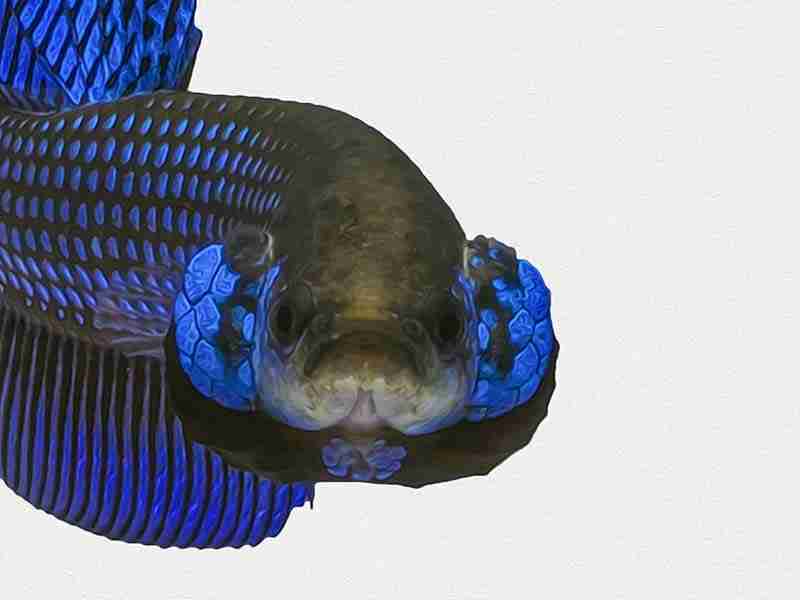
Do Betta Fish Get Bored
Because of their intelligence, you may ask the question, “Do betta fish get bored?” A lack of stimulation in your betta’s tank can cause them to get lonely and bored. Good betta care involves you interacting with your fish regularly or providing them with some form of stimulation, such as a betta mirror.
A betta ball is also an ideal form of stimulation, and you will often find an entire range of betta exercise equipment for sale in many pet stores.
Music is another way to interact with your betta, but can betta fish hear music? Betta fish cannot hear music like you or me, instead, they feel vibrations given off by the music, which gets amplified through the water.
Many betta owners have reported interesting behaviors when playing music to their fish, and some owners insist that their betta even has a favorite type of music.
Don’t play anything too loud because the vibrations, when amplified through the glass and water, may cause your betta to become frightened and stressed instead of soothed or aroused.
Betta Fish Breeding
Betta fish breeding can be a wonderful experience for any betta fish owner, and their mating ritual can be very interesting to watch. Betta fish are not difficult to breed if they are healthy and live in the right conditions.
I wrote an article answering the question, “How long are betta fish pregnant for?” because it’s something I feel is asked quite a lot. Betta fish are not livebearers and instead will lay eggs during the mating process, so a female betta will only be pregnant with eggs that are waiting to be fertilized by a male partner.
Betta Fish Bubble Nest
Bettas are well known for building bubble nests out of saliva and under the cover of plants or decorations. The male betta will put enormous energy into building the nest and immediately begin to court the female by displaying his fins and dancing around her. It can be pretty interesting watching these usually solitary fish perform their mating ritual.
The female betta will lay her eggs in the bubble nest. The eggs are then immediately fertilized by the male betta. The eggs will be stuck to the nest as a form of protection and warmth using a sticky protein substance.
If you are interested in reading more about betta fish breeding and mating habits, you can read: Why Do Bettas Make Bubbles?
How To Protect Betta Babies (Fry)
Once mating is over, it is best to remove the female betta, which is more likely to eat the eggs before they have hatched. A male betta will tend the nest until the fry has hatched, at which point it would be best to segregate the fry until they have grown large enough to fend for themselves.
I highly recommend reading Baby Betta Fish (Care and Feeding Guide) if you are interested in learning more about breeding.
Common Betta Diseases And Symptoms
Like all fish, betta fish are susceptible to illness and disease. When Providing good betta fish care, it would be wise to understand which illnesses are most common and the signs or symptoms to look out for.
Although betta fish are susceptible to the same illnesses as many other fish, a few are more common.
The four most common illnesses among betta fish are:
- Fin Rot
- White Spot (Ich)
- Velvet
- Dropsy
- Swim Bladder Disease
Apart from Dropsy which can often be more serious (but still treatable), the other three are easily treatable if caught early. Good betta care will require you to look for symptoms of illness before the condition becomes untreatable.
Betta Fish Fin Rot
Fin rot in betta fish is the deterioration of the fish’s fins. Since betta fish have long and beautiful flowing fins, it becomes very painful for betta owners when they notice that their betta fish are suffering from fin rot.
In most cases, Fin Rot will develop due to poor water conditions, including low temperatures, ammonia toxicity, and overcrowding. However, the exact cause of fin rot is not known.
A betta fish can recover from fin rot if caught early enough after the fins start deteriorating. However, since it is difficult to diagnose whether a betta fish has fin rot or not, you must regularly look at your pet betta for any signs of deterioration in his fins.
Symptoms of Fin Rot In Betta Fish
If your betta fish has Fin Rot, the main symptom will be fins that look uneven or may have a soft mushy appearance. They can become milky white, brown, black, or even transparent in appearance.
Other Symptoms are:
- Loss of appetite
- Clamped Fins
- Lethargy (Hiding and very inactive)
- Secondary infections such as gill rot, tail rot, and body rot.
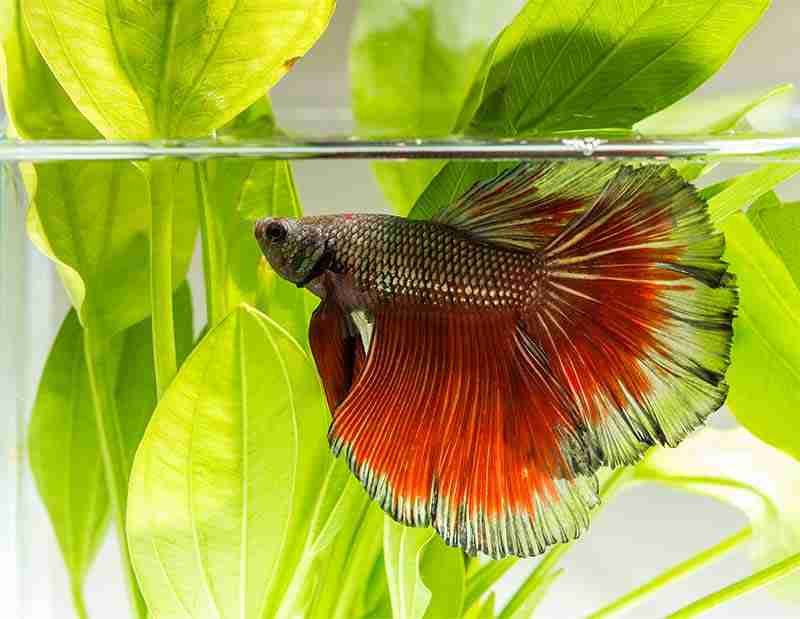
For more information on betta fin rot, you can read, What Causes Fin Rot In Bettas (Symptoms & Treatment Guide).
Betta Fish White Spot
White Spot or Ich is a common and highly contagious infection that can affect betta fish and is most often seen in the less-than-adequately maintained aquariums of pet stores.
A tiny parasitic organism causes a white spot called a ciliate protozoan, specifically, a Hexamita parasite. It attaches itself to the betta fish and burrows into its body, causing irritation and stress on the fish’s immune system and leading to secondary infections such as fin rot and bloating.
The infection is highly contagious among bettas, so if you have a fish with white spot, it is best to separate it from any other bettas until the infection clears.
Symptoms of White Spot in Betta Fish
The first sign of white spot is often on the fish’s head or face and will develop into small white cysts, which are hard to see at first but make themselves known with their whitish film on top of the fish, which is often mistaken for salt deposits.
Other symptoms are:
- Loss of appetite.
- Clamped fins.
- Darting eyes.
- Constant scratching on ornaments or plants in the aquarium or even against the tank glass.
- Loss of scales on the body or head.
Treatment for White Spot in Betta Fish
White spot is treatable with a White Spot Cure found at most fish stores, but it must be applied continuously and often over a period of 3 weeks.
For more information on betta white spot, you can read: White Spots on Betta Fish – Identifying the Ich Parasite.
Betta Fish Velvet Disease
Velvet disease in betta fish is caused by a parasite known as Oodinium. The condition is also called velvet, gold dust, and brown algae due to the color of the parasites within the betta’s body.
Symptoms of Velvet Disease in Betta Fish
Velvet disease in betta fish will appear as yellow or white spots on different parts of your betta’s body. The spots will also feel like sandpaper, and the betta’s skin will begin to look uneven.
Other symptoms of velvet disease in betta fish include:
- Rapid gill movement (gasping for air).
- Lethargy or depression.
- Loss of appetite.
- Increased respiration rate.
- Loss of scales on the body or head.
Treatment for Velvet Disease in Betta Fish
Since a parasite causes the disease, you will need to use an anti-parasite medication. It’s best to treat your betta fish as soon as possible since this disease can be fatal. Make sure to check the medication out thoroughly beforehand and follow all of the instructions provided.
Betta Fish Dropsy
A bacterial infection causes Dropsy in betta fish. Usually, your betta fish will display symptoms of bloating, scales standing out on the body, and holes in the scales. As Dropsy worsens, the betta fish’s scales may start to stick out even more, and his belly might become red or bloody.
Treating your betta fish for Dropsy involves the use of antibiotics. Ensure to read about this treatment thoroughly and follow all of the instructions, as improper usage will only worsen the disease.
Betta Swim Bladder Disease
Swim bladder disease in bettas is not actually a disease in itself but, instead, a disorder or condition caused by an underlying illness/condition. In some cases, swim bladder disease can be genetic and would therefore be untreatable.
The bettas swim bladder is an internal airbag that inflates and deflates to help with buoyancy in the water. When your betta has a swim bladder disorder, their ability to swim will be compromised.
Many fish can live with swim bladder disorder, especially when it has been present from birth, provided it doesn’t interfere with a fish’s ability to feed.
The most obvious symptoms of swim bladder disease in betta fish are:
- Swimming upside down.
- Floating on the side or floating vertically.
- Bobbing around the tank uncontrollably, especially within the current.
- Inability or lack of control in up or down movement through the tank.
If you are interested in reading more about swim bladder disease in betta fish, I have written a great article: Swim Bladder Disease In Bettas. This guide is very informative and will provide everything you will need to know in diagnosing and treating the condition.
Causes of Illness In Betta Fish
Bettas fish will often become more susceptible to illness when stressed, which can severely impact their immune system. If your betta fish is suffering from recurring illness or is not responding quickly to treatments, you will need to examine whether their environment is causing them stress.
Illness is most often caused by bacteria or parasites and can easily be avoided with knowledge and care.
Bacteria and parasites can inadvertently be introduced to your tank when adding new fish, plants, or substrates that are infected or harboring the parasite. A best practice is to thoroughly wash everything before it is added to your betta tank and quarantine new fish in a separate tank for several days while you monitor them for symptoms of illness.
Bacterial infection is often caused by poor water conditions in which dangerous bacteria will thrive. Harmful bacteria can also be introduced accidentally when adding infected fish to your tank. In a well-kept tank, this bacteria will often not survive very long and instead be overwhelmed by high levels of good bacteria.
Suppose your betta fish is suffering from a bacterial infection. In that case, you first need to check your aquarium for poor water quality and check that your aquarium heater is set to the right temperature.
Poor water quality can be caused by a lack of general maintenance and cleaning. Uneaten food will decay and poison the aquarium water sending your fish tank ammonia levels through the roof, becoming the ideal environment for nasty bacteria to breed.
Using a good filtration system will help keep the water clean, an air pump will help keep the water oxygenated, and regular water changes will be the most effective defense for the entire tank.
General Symptoms Of Illness In Betta Fish
Because there are so many illnesses that can affect your betta, it would be difficult to give the symptoms of any specific disease. Fin rot, for instance, would show a rotting of the fins, while ich displays as tiny white spots. Any abnormalities you notice will need to be researched, or you should speak with a specialist.
I can give you a generalized list of symptoms that your betta fish may display when unwell, and these are often a good, early indicator that something is wrong.
Some of the most common symptoms of illness are:
- Your betta is not eating.
- Your betta is lethargic and slow.
- Your betta has a bloated stomach.
- Fish’s scales stand out (this could be due to dropsy, but not always).
- White spots on the fins or body of betta fish – may indicate an illness such as Ich or white spot disease.
- Fish has heavy breathing or a hunched appearance and stays at the water’s surface.
Often betta fish will display a mixture of these symptoms, and if this is the case, you may need to seek help immediately. Although an illness may not seem very serious at first, leaving it for too long can lead to further complications down the line. Betta fish will also show particular behaviors before death, which you can read: Betta Fish Behavior Before Death.
The best advice that I can give you is that as soon as you suspect that there is something wrong with your betta fish, you should always seek help. Many tropical fish keepers are experienced in the art of caring for their bettas and will often be able to give you sound advice on what best to do next.
It’s also worth remembering that it’s not only illnesses that can affect your fish but also the water you provide them. Poor water can often lead to disease, so ensuring that your betta’s home is maintained correctly at the right temperature and the right pH level is vital.
Betta Fish Scale Loss
One symptom that can appear in many illnesses is scale loss. There can be many reasons behind scale loss in betta fish, including natural aging or injuries.
Because scale loss is quite common, I have written an article, “Betta Fish Losing Scales – Typical Causes and Solutions,” which I would recommend you read if you have a betta fish that is dropping scales inexplicably.
Betta Fin Curling
Fin curling is also a common symptom when a betta fish is under the weather or feeling stressed. Fin curling in betta fish will be much more noticeable due to their long fins and is often an early indicator that there may be a problem. Take a read of the article “Betta Fish Fin Curling – Common Causes and Fixes” if you have noticed the symptom in your betta fish.
Betta Stress Stripes
I have talked about stress a few times throughout this article because it is commonly experienced by betta fish, especially with their fiery temperaments. It is important to notice when your betta gets stressed because it can negatively impact their immune system.
One telltale sign of stress in betta fish is the sudden development of horizontal stripes along the length of their body. These stripes are often called stress stripes or lines and fear stripes or lines.
Stress stripes are more commonly seen on female betta fish, although they do still occur on males and can appear as dark or black lines or lines that are just darker than the surrounding color.
In most cases, stress stripes are nothing to worry about, and they can disappear as quickly as they appeared. There is often a reason why stress lines appear, and it would be best to try and identify what is causing stress to your betta to avoid any reoccurrence.
Euthanizing Betta Fish
I have deliberately left this section to the end and directly after the sections about betta illnesses because I think it is relevant and should be mentioned.
Betta owners will often become quite attached to their pet betta fish, and when illness sets in, it can be difficult. Sometimes an illness is untreatable, or maybe your betta has become old and struggling to survive.
Whatever the reason, if your betta fish is not getting better after treatments and is suffering in pain with no quality of life, euthanasia should be considered a kinder option, which will spare further suffering.
You can euthanize a betta fish at home using some clove oil which is an anesthetic, or you could request the help of a veterinarian.
I have written an article on the subject of euthanizing betta fish, which you should read: How To Euthanize A Betta Fish (Humanely & Painlessly).
Wrap Up
Providing good betta care is not a difficult task once you have some solid knowledge of the species. Like any tropical fish, siamese fighting fish need a healthy and comfortable environment to grow.
An aquarium hobby is not very labor-intensive compared to looking after a dog or cat, but it is often easy to forget about your betta’s needs beyond feeding them 2 or 3 times a day.
I hope that this guide has helped give you a better understanding of good betta fish care, and good luck if you’re looking after your own betta fish!




